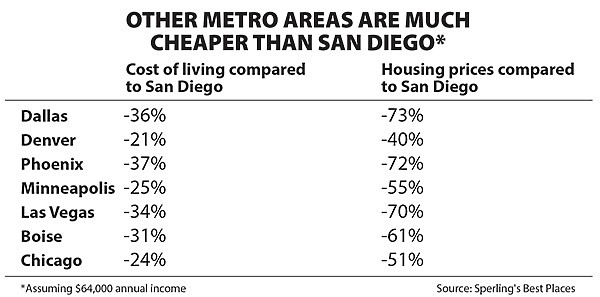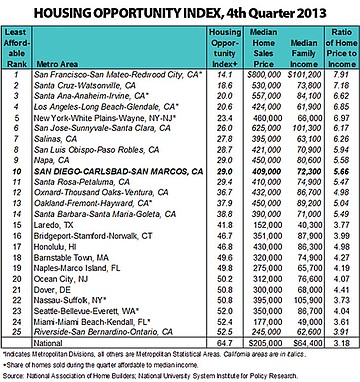 Facebook
Facebook
 X
X
 Instagram
Instagram
 TikTok
TikTok
 Youtube
Youtube

Ever wonder why there’s a lack of fannies in the seats at those occasionally blacked-out Charger games? Or why attendance and donations plunged at the now-defunct San Diego Opera?

You won’t go wrong putting part of the blame on San Diego’s sunshine. San Diegans get psychic income. The county’s cost of living (groceries, housing, utilities, transportation, health care, and miscellaneous) is 29.2 percent higher than the nation’s, according to the cost-of-living index published quarterly by a research organization that goes by the acronym ACCRA. But San Diegans’ median household income is only 12.3 percent above the nation’s. Result: very high living costs, moderate incomes…a huge gap between money in and money out for most households.

This means lower savings and less disposable income for San Diegans. “People buy stuff on credit. Other spending has to be reduced,” says Kelly Cunningham, economist for the National University System Institute for Policy Research. Cunningham did a special study on the cost of sunshine for the Reader.

The Chargers, true to their name, charge too much for a city suffering from the sunshine cost. According to Team Marketing Report, tickets for a family of four, plus parking, beer, soft drinks, and the like, cost $479.21, tenth highest in a league of 32 teams. Similarly, San Diego Opera may have pushed ticket prices too high. Because of the sunshine cost, San Diegans “spend less on entertainment. Other studies have shown that,” says Cunningham. Another reason is the many outdoor activities that don’t cost much money.

The only two major metro areas that have wider money-in/money-out gaps than San Diego are Los Angeles (cost of living 31 percent higher than the nation’s, income 4 percent lower) and Miami (cost of living 7 percent higher but income 24 percent lower, greatly influenced by the large number of retirees there).
San Francisco’s cost of living is a whopping 59.9 percent above the national level, but its median household income is 57.1 percent higher. San Jose’s cost of living is 48.8 percent higher than the nation’s, but its median family income is 57.3 percent higher. Yes, Bay Area costs are higher, but incomes are higher, too. San Diego, Los Angeles, and Miami can’t say that.
San Diego’s housing costs are among the highest in the world. The tenth-annual Demographia international housing affordability survey lists the least affordable metro areas in mainly English-speaking, high-income countries. Worst is Hong Kong, followed in order by Vancouver, San Francisco, Sydney, San Jose, Melbourne, Auckland, San Diego, Los Angeles, and London. So San Diego is the eighth least affordable large city.
All those metro areas are considered “severely unaffordable” by Demographia. By contrast, the most affordable markets are all in the United States: St. Louis, Indianapolis, Cleveland, Cincinnati, Buffalo, Atlanta, Rochester (N.Y.), Grand Rapids, Detroit, and Pittsburgh.
The housing opportunity index calculated by the National Association of Home Builders and Wells Fargo reveals that of the 14 least affordable metro areas in the United States, 13 are in California. (The study includes smaller metro areas than are in the Demographia study.) In San Francisco, a mere 14.1 percent of families earning the median income can afford the median-priced home. In Santa Cruz, it’s 18.6 percent. San Diego is in tenth place; only 29 percent of families with median incomes can afford the median-priced home.
In order, the nation’s 14 least affordable metro areas are San Francisco, Santa Cruz, Orange County, Los Angeles, New York/New Jersey metro, San Jose, Salinas, San Luis Obispo, Napa, San Diego, Santa Rosa, Oxnard, Oakland, and Santa Barbara.
So if you want to ditch the sunshine cost, what do you do? For one thing, you could move to Minneapolis. Sperling’s Best Places is a website that allows people to check the cost of living of one city against another. If you earn $64,000 in San Diego (roughly the median household income), you could get the same amenities in Minneapolis earning $48,138. The cost of living is 25 percent lower than in San Diego, and housing prices are 55 percent lower. The cost of living in Minneapolis is only 2 percent above the nation’s, but incomes are 29 percent higher.
But in case no one has told you, it is frigid up there. Minnesotans reap a cold-weather bonus, the reverse of San Diegans bearing a sunshine cost. Possibly corporations “have to pay people to live there,” jokes Cunningham.
Of course, if you really want to save, you can move to Detroit, where the cost of living is 45 percent lower than San Diego’s and housing is 87 percent cheaper, according to Sperling’s. Your $64,000 salary could shrink to $35,461. In Youngstown, Ohio, it would go down to $35,264.
But do you want to live in Detroit or Youngstown? “People are paying for lifestyle in California,” says Cunningham. One reason California housing prices are so high is that governments tack on so many costs to build a home, he says. However, people still buy those homes, he concedes.
Of course, you could save money moving to cities more desirable than Detroit and Youngstown. In Phoenix, your $64,000 could shrink to $40,414; the cost of living is 37 percent lower than in San Diego and housing is 72 percent cheaper, according to Sperling’s. In Denver, the cost of living is 21 percent lower and housing is 40 percent cheaper. Your $64,000 could drop to $50,667 with an equivalent lifestyle. In Dallas, the cost of living is 36 percent lower and housing 73 percent cheaper.
According to ACCRA data, in many major metro areas the median household income is higher than the national average but the cost of living is lower. Theoretically, a family could come out ahead just living there. Those metro areas: Austin, Raleigh, Charlotte, Richmond, San Jose, Cincinnati, Pittsburgh, Atlanta, St. Louis, Dallas, Cleveland, Houston, Denver, Seattle, and Washington, D.C.
In recent years, more San Diegans have been leaving than arriving each year. These cost-of-living and housing-price statistics partly explain that.


Ever wonder why there’s a lack of fannies in the seats at those occasionally blacked-out Charger games? Or why attendance and donations plunged at the now-defunct San Diego Opera?

You won’t go wrong putting part of the blame on San Diego’s sunshine. San Diegans get psychic income. The county’s cost of living (groceries, housing, utilities, transportation, health care, and miscellaneous) is 29.2 percent higher than the nation’s, according to the cost-of-living index published quarterly by a research organization that goes by the acronym ACCRA. But San Diegans’ median household income is only 12.3 percent above the nation’s. Result: very high living costs, moderate incomes…a huge gap between money in and money out for most households.

This means lower savings and less disposable income for San Diegans. “People buy stuff on credit. Other spending has to be reduced,” says Kelly Cunningham, economist for the National University System Institute for Policy Research. Cunningham did a special study on the cost of sunshine for the Reader.

The Chargers, true to their name, charge too much for a city suffering from the sunshine cost. According to Team Marketing Report, tickets for a family of four, plus parking, beer, soft drinks, and the like, cost $479.21, tenth highest in a league of 32 teams. Similarly, San Diego Opera may have pushed ticket prices too high. Because of the sunshine cost, San Diegans “spend less on entertainment. Other studies have shown that,” says Cunningham. Another reason is the many outdoor activities that don’t cost much money.

The only two major metro areas that have wider money-in/money-out gaps than San Diego are Los Angeles (cost of living 31 percent higher than the nation’s, income 4 percent lower) and Miami (cost of living 7 percent higher but income 24 percent lower, greatly influenced by the large number of retirees there).
San Francisco’s cost of living is a whopping 59.9 percent above the national level, but its median household income is 57.1 percent higher. San Jose’s cost of living is 48.8 percent higher than the nation’s, but its median family income is 57.3 percent higher. Yes, Bay Area costs are higher, but incomes are higher, too. San Diego, Los Angeles, and Miami can’t say that.
San Diego’s housing costs are among the highest in the world. The tenth-annual Demographia international housing affordability survey lists the least affordable metro areas in mainly English-speaking, high-income countries. Worst is Hong Kong, followed in order by Vancouver, San Francisco, Sydney, San Jose, Melbourne, Auckland, San Diego, Los Angeles, and London. So San Diego is the eighth least affordable large city.
All those metro areas are considered “severely unaffordable” by Demographia. By contrast, the most affordable markets are all in the United States: St. Louis, Indianapolis, Cleveland, Cincinnati, Buffalo, Atlanta, Rochester (N.Y.), Grand Rapids, Detroit, and Pittsburgh.
The housing opportunity index calculated by the National Association of Home Builders and Wells Fargo reveals that of the 14 least affordable metro areas in the United States, 13 are in California. (The study includes smaller metro areas than are in the Demographia study.) In San Francisco, a mere 14.1 percent of families earning the median income can afford the median-priced home. In Santa Cruz, it’s 18.6 percent. San Diego is in tenth place; only 29 percent of families with median incomes can afford the median-priced home.
In order, the nation’s 14 least affordable metro areas are San Francisco, Santa Cruz, Orange County, Los Angeles, New York/New Jersey metro, San Jose, Salinas, San Luis Obispo, Napa, San Diego, Santa Rosa, Oxnard, Oakland, and Santa Barbara.
So if you want to ditch the sunshine cost, what do you do? For one thing, you could move to Minneapolis. Sperling’s Best Places is a website that allows people to check the cost of living of one city against another. If you earn $64,000 in San Diego (roughly the median household income), you could get the same amenities in Minneapolis earning $48,138. The cost of living is 25 percent lower than in San Diego, and housing prices are 55 percent lower. The cost of living in Minneapolis is only 2 percent above the nation’s, but incomes are 29 percent higher.
But in case no one has told you, it is frigid up there. Minnesotans reap a cold-weather bonus, the reverse of San Diegans bearing a sunshine cost. Possibly corporations “have to pay people to live there,” jokes Cunningham.
Of course, if you really want to save, you can move to Detroit, where the cost of living is 45 percent lower than San Diego’s and housing is 87 percent cheaper, according to Sperling’s. Your $64,000 salary could shrink to $35,461. In Youngstown, Ohio, it would go down to $35,264.
But do you want to live in Detroit or Youngstown? “People are paying for lifestyle in California,” says Cunningham. One reason California housing prices are so high is that governments tack on so many costs to build a home, he says. However, people still buy those homes, he concedes.
Of course, you could save money moving to cities more desirable than Detroit and Youngstown. In Phoenix, your $64,000 could shrink to $40,414; the cost of living is 37 percent lower than in San Diego and housing is 72 percent cheaper, according to Sperling’s. In Denver, the cost of living is 21 percent lower and housing is 40 percent cheaper. Your $64,000 could drop to $50,667 with an equivalent lifestyle. In Dallas, the cost of living is 36 percent lower and housing 73 percent cheaper.
According to ACCRA data, in many major metro areas the median household income is higher than the national average but the cost of living is lower. Theoretically, a family could come out ahead just living there. Those metro areas: Austin, Raleigh, Charlotte, Richmond, San Jose, Cincinnati, Pittsburgh, Atlanta, St. Louis, Dallas, Cleveland, Houston, Denver, Seattle, and Washington, D.C.
In recent years, more San Diegans have been leaving than arriving each year. These cost-of-living and housing-price statistics partly explain that.
Comments